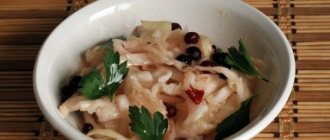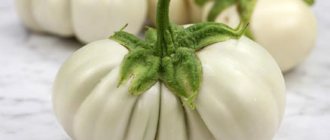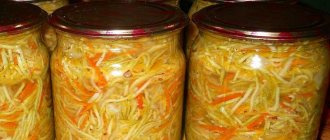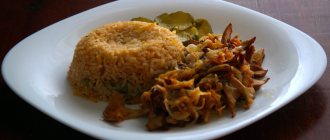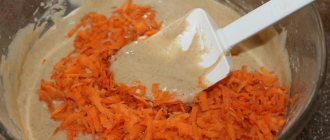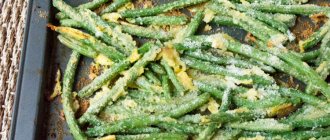Hello everyone, friends!
Today I would like to tell you a little about Korean cuisine. Before this, I only covered the topic of skin care in the land of morning freshness. But South Korea is famous not only for its cosmetics, but also for its healthy food.
Korean kimchi is their traditional dish, which has quite interesting taste qualities. I will share with you information about the health benefits of kimchi, how it is fermented, and how to make it at home.
Introduction
When asked what dish you consider the national symbol of Korea, ten out of ten Koreans will answer chimchi without hesitation. By the way, what is the correct way to say chimchi or kimchi? I believe that these are different names for the same dish - spicy pickled Chinese cabbage. The most complete, correct and classic recipe for fermented chimchi salad was born in Korea.
For ethnic Koreans living in the USSR, the classic products used in Korea for its production were not available. Hot pepper “kochu koru”, rice flour, fish sauce, adinomodo – flavor enhancer.
Ginger, leaves of the gaat plant native to Asia, sea kelp, certain varieties of pears and apples, dried mini shrimp, shiitake mushrooms and other ingredients.
There are many recipes for classic chimchi in Korea; they even hold a chimchi festival, where more than 200 varieties, methods of pickling and even placing in barrels are presented annually.
Therefore, in the Far East, Kazakhstan, Sakhalin, and Central Asia, Korean cuisine differs from each other. In the Far East it is spicy, with a lot of fish, seafood and wild plants. The southern regions have more vegetables, fruits, spices and herbs.
Even the well-known salad in Russia called “Korean carrots” has no analogue in Korea. It is believed that carrots became a substitute for the Korean dish “turaji”, prepared from the root of the campanula latifolia.
My husband and I lived on Sakhalin for a long time. We love, appreciate and know how to cook many dishes from the arsenal of Sakhalin Koreans. He makes excellent chimchi with the addition of salty, steeply cooked pink salmon broth. He adds pieces of pink salmon to it for salting and fermentation.
When the chimchi is ready, from one pickling we have two dishes on the table, a spicy salad and pieces of lightly salted, spicy pink salmon fillet.
His cuisine is still islandish for me. Reducing the amount of pepper in his dishes always succeeds with scandal. And I came up with my own version of pickling Pekinka. And she called it “chimchi for girls.” It's not as hot and sour as my husband's, but just as tasty, crispy and beautiful.
Choosing Chinese cabbage for chimchi
Choosing Pekinka for salting is an important point. The heads of cabbage should be dense, mature, rounded at the top and have white streaks reaching to the middle. There should be no rot or damage on the surface of the leaves. According to Korean canons, the best Chinese cabbage for pickling should be collected from the fields after the first frost.
Here in Adygea, frost is still a long way off, and I was unable to find out where and when the cabbage presented in the store was picked. I bought three forks, 35 rubles per kilogram. They pulled 3.2 kg of Beijing, for 113 rubles for everything. The forks looked good, ripe, dense. The outer leaves are healthy, clean, undamaged, with a green tip and white veins down the middle.
I decided for myself - I’ll leave 2 heads of cabbage for pickling, and use the rest of the Peking cabbage in a salad. I cut the heads of cabbage in half, lengthwise, and in the middle into equal parts. I renewed the stalk, cutting off part of it to the leaves. The oven is ready for salting.
Pickling Peking for chimchi
First, I lightly salted the base of the Chinese cabbage at the stalk. The thickest leaves are there. Take a pinch of coarse salt and gradually remove the leaves. I spent about a tablespoon of salt on four halves of Beijing.
We make tuzluk - a salt solution for pickling. For two forks of Chinese cabbage, I needed 4 liters of water and 12 heaped spoons of coarse table salt. We use regular salt for pickling and brine, never iodized.
Pour the brine into a large, deep enamel or plastic container, into which the cabbage will easily fit, and the brine will completely cover it.
I got two layers of two pieces each. We leave the Beijing to pickle for a day, at room temperature. Placing it with the cuts down, we place oppression on top. After 12 hours, swap the top and bottom layers of the peking. We lower the top ones down, raise the bottom ones up.
After a day of salting, we remove the oven from the container using the “wet method”. Cut a piece of lettuce at the base and taste it - it should be salted. Another way to check is to fold back the outer leaves. After a day in brine, they should become elastic, pliable and bend outward well.
If there is a lot of salt in the leaves, rinse thoroughly with cold water and vice versa, if you add little salt. I got it just right - lightly salted taste. We put the salted heads of cabbage in the sink and let them drain thoroughly.
How to salt Chinese cabbage kimchi with sparkle
Another correct recipe for a spicy salad that can be fermented for the winter. Nuclear snack, not for everyone. Be careful if trying for the first time.
- Cabbage - 2 heads.
- Carrot.
- Daikon - a couple of pieces.
- Sweet pepper - 3 pcs.
- Salt - 1.5 cups (plus a little for sprinkling leaves).
- Water - 20 cups.
- For the pickling sauce:
- Water - 1.5 cups.
- Boiled rice - 1.5 cups.
- Ginger root - 2 cm.
- Garlic - 2 heads.
- Ground chili pepper - 2/3 cup.
- Dry chili pepper - 20 pods.
- Bulb.
- Sesame seeds - spoon.
- Sugar - 2.5 tablespoons.
- Fish sauce - 0.2 cups (optional).
How to make kimchi:
- Divide the head of cabbage into 4 parts, cut out the stalk. Cut the quarters into pieces 3-4 cm long.
- Place in a bowl and sprinkle with salt.
- Cut the daikon into thin ring halves. Add to cabbage.
- Pour 20 cups of warm water into a saucepan, add 1.5 cups of salt. Pour over the cabbage preparations. Salt for 3 hours.
- Rinse the sheets thoroughly and let the water drain.
- Make the kimchi sauce: cook the rice until tender, fry the sesame seeds in a dry frying pan.
- Combine rice with sesame seeds, add the remaining ingredients listed in the recipe. Punch with a blender.
- Coat the pekin leaves with paste sauce on all sides (the first recipe describes in detail how to do this).
- Cut the carrots and bell pepper into thin strips. Send to cabbage. Mix carefully so as not to disturb the integrity of the pieces.
- Place in jars. Take containers with a wide neck so that you can press the workpiece down with pressure on top. Do not fill to the top, leave a little space for the fermentation process.
- Leave at room temperature for a day. Then tighten the jars and place them in the cold. Kimchi will be ready in a week. The salad can be stored all winter without loss of taste; the longer it sits, the more flavorful the appetizer.
Preparing the Kankochi Garlic Pepper Spread
Let's start preparing the garlic-pepper spread - it's called “Kankochi”. Her recipe:
For a head of Chinese cabbage, I use one Bulgarian and two hot ones. I clean the peppers, removing the tails, seeds and membranes. You will need one head of garlic. Per tea l. sugar, heaped paprika (for color) and salt. I have two forks of Chinese cabbage, so I double the amount of all the ingredients for the spread.
Chimchi dressing can be made in reserve. For long-term storage in the refrigerator. To do this, add two tablespoons of salt to the kankochi instead of one. Then it can be stored in the refrigerator for a long time. If you don't add salt, the kankochi may turn sour.
I pass the pepper and garlic through a meat grinder. I add salt, sugar, paprika to them and mix. When I make paste from dry pepper “Kochu-koru”, I pour boiling water over it until the sour cream becomes thick.
But today I made pepper paste from fresh peppers. I didn't need boiling water. My husband also adds ginger and coriander, I don’t make cabbage with them, I don’t like them.
I split half the heads of cabbage in two. Now according to the canons, cutting along to the middle, and then tearing it with my hands. I cut out a triangle of stalks at the base. This will soak the chimchi faster and more evenly and make cutting the finished salad more convenient. Bending back each leaf, I generously lubricate it from the inside with pepper paste.
Important: Girls, we do this part of the salting with gloves. Otherwise, you will burn the skin on your hands with pepper.
I stuff the pecha tightly into the container, alternating the tails and butts of the pekinka with each other. Place with the cut side up. I also coat the incision generously with pepper spray. The salad became very bright, beautiful and elegant. When the last layer of Beijing is laid, I put pressure on top and leave it at room temperature for an hour.
Those who like chimchi sour can leave it for a longer period - up to two days. You just need to keep trying it. During this time, it ferments more strongly, gives more juice and sours. Don't overdo it or it will become very sour. Make sure that the juice covers all the heads of cabbage.
Tip: If the chimchi turns out to be very spicy or salty, add a little clean, cold water to the brine. Water will remove the heat and reduce the salty taste. Conversely, add salt and pepper if it is not hot and salty enough.
Be sure to close the container with a lid, if not, then with cling film. Otherwise, the top layers of chimcha will become airy, and all the food in the refrigerator will smell of its spirit. I put it in the refrigerator for three days. We started trying and eating it within a day. The chimchi turned out to be slightly spicy, crispy and incredibly tasty.
My husband, who was initially critical of my experiment, was the first to admit this.
As you can see, girls, there is nothing complicated or supernatural about pickling chimchi. Every housewife can salt it at home.
Classic kimchi from Chinese cabbage for the winter
Here is a simplified traditional recipe for preparing it at home, on the basis of which you can make several variations of the dish. The appetizer includes daikon, onions, cauliflower, and carrots. Variety of seasonings.
- Beijing - 5 kg.
- Sugar - ½ large spoon.
- Garlic - 150 gr.
- Water - 4 liters.
- Salt - 400 gr.
- Ground red pepper - ½ cup.
Step-by-step cooking recipe
- Disassemble the cabbage into leaves. Throw away the substandard ones. Rinse good leaves with water and dry them on a paper towel.
- Make a brine by dissolving salt in water. Fold the leaves. The water should completely cover the cabbage (it’s more convenient in a wide pan).
- Press down with pressure and leave for several hours. Usually this procedure is done at night.
- Pour a glass of brine into a separate bowl. Pour out the rest of the liquid; it will no longer be needed.
- Rinse the pekinka leaves under running water and dry again.
- Make the kimchi paste: add sugar, red pepper, and crushed garlic to the poured brine. Stir the paste. Rub the leaves with the paste (wear gloves so as not to get burned by the burning mass).
- Place it in a container for the workpiece, cover it with a plate and place a weight on top. Take dishes that you don’t mind throwing away, since the smell after salting disappears for a very long time.
- There is no need to hide it in the cold; leave it at room temperature. The workpiece will begin to ferment.
- After a few days, the fermentation process will end. Once the kimchi has “calmed down”, transfer to jars. Store in a cool place.
What is kimchi used with and what dishes is it added to?
As I already said, Koreans eat chimchi for breakfast, lunch and dinner, 365 days a year. This salad is always present on their table. It is used both as an independent snack and as an additive included in many Korean dishes. Chimchi is used in the preparation of Sundae, a Korean blood sausage.
It is also included in some recipes for “Pyanse” - Korean steamed pies with meat and vegetable filling, Korean dumplings “Mandu” consisting of many components. Of course, the legendary and incredibly tasty dish - pork fried with chimchi - is not complete without chimchi. This appetizer is good and simply fried with onions.
Chimchi brine and leaves are added to many first courses in Korean cuisine. Neither fish nor vegetable soup can do without it. It makes their taste sharp, spicy and unique. The taste is unlike any soup you have tried before.
The benefits of chimchi for the body
Koreans, a people with a long history, believe that chimchi adds intelligence to a person and gives longevity. And indeed it is. This low-calorie, fermented food is proven to be rich in vitamins, beneficial bacteria and probiotics. Capable of establishing the required level of required enzymes and microorganisms, normalizing the flora in the intestines.
Regular consumption of chimchi helps reduce blood cholesterol levels. The substances contained in it help normalize the functioning of the heart. And oxidants protect cells from damage, slow down skin aging and prevent many types of cancer.
Chimchi is good for weight loss. 100 g of product contains only 35 calories. Thanks to capsaicin contained in hot peppers and fiber, which is rich in salad, it can speed up the absorption and metabolism in the body.
Chimchi also helps strengthen the immune system, reduces blood sugar in diabetics, normalizes blood pressure and improves brain function. Real cooking ginseng. This is a rare case when something healthy can be tasty.
Health benefits of kimchi
Fermented food consists of beneficial microorganisms that are essential for maintaining the human immune system. If the bacteria in the body are not properly balanced, a variety of health problems can occur, including allergies and immune disorders.
Over the past few years, many studies have shown that all forms of microorganisms such as bacteria, fungi and viruses play an important role in the proper functioning of our body. What exactly are they doing?
- Suppress inflammation and growth of pathogenic bacteria;
- Produce vitamins, amino acids, absorb metals and remove toxins;
- Effectively fight asthma and reduce allergies;
- Balance emotional and mental state;
- Controls weight and promotes weight loss.
In particular, chimchi is rich in vitamins A and C, as well as lactic acid bacteria that arise during the fermentation process. Animal studies have shown that the microorganisms produced in it have antioxidant and immunomodulatory properties, and are also effective against obesity.
Kimchi also has an antimicrobial effect against pathogenic bacteria and is capable of destroying pesticides absorbed by the body during its life. Thus, kimchi can be considered a healthy plant-based probiotic food, in no way inferior to yogurt and other fermented milk products.
At its core, chimchi is even healthier than yogurt because it contains many wonderful vegetables such as Chinese cabbage, garlic, ginger and onions.
So, what benefits does eating kimchi give to a person?
- Cancer prevention;
- Gut health;
- Improving brain function;
- Obesity prevention;
- Probiotic effect;
- Getting rid of antioxidants;
- Increased immunity;
- Preventing constipation;
- Reducing cholesterol levels;
- Anti-aging effect;
- Improved skin condition;
- Stroke prevention;
- Preventing diabetes.
How much did it cost me to make chimchi?
Now there are departments of Korean salads in many large cities, in almost every food market in Russia. Having visited many of them from Sakhalin to Sochi, I almost never buy chimchi there. Still, what Koreans do for themselves and for sale are two different products. It’s somehow a pity to pay 100-200 rubles for a small bag of incomprehensible chimcha.
We learned a long time ago and make this dish for ourselves. We add as much salt, pepper, and garlic to it as we like. Moreover, it is actually not expensive at all. More than two kilograms of Beijing cost me 75 rubles. Garlic, hot and bell peppers all together cost another fifteen rubles.
Paprika, salt and sugar are mere pennies. As a result, I received 2.5 kilograms of a tasty and healthy product. It cost two hours and a little more than 90 rubles. At the same time, you will enjoy cooking and save a lot of money. On the market, I would have spent 8-10 times more money to buy this amount of chimchi.
Video recipe.
Classic kimchi seasoning
To prepare you will need:
- 2 pcs. Chinese cabbage (about 2 kg);
- 1 piece each onions and large carrots;
- 1 tbsp. garlic cloves, 50–60 gr. ginger root;
- 3–4 tsp. red hot pepper, 2–3 tbsp. rice flour;
- 2 tsp sugar, 150 ml. fish sauce.
Step by step instructions:
- Wash the heads of Chinese cabbage and cut each head lengthwise into 4 pieces. Prepare brine at the rate of 100 g. salt per 1 liter of water. Place the cabbage in a large saucepan and cover with brine. There should be enough brine to completely cover the cabbage.
- Therefore, it is better to cook it after filling the pan. Leave the cabbage to salt for 12 hours. You can keep vegetables in brine for fewer hours, but it is believed that the longer the better.
- Mince garlic, ginger root and onion through a meat grinder. Cook rice jelly. Stir rice flour in two glasses of water, bring to a boil, stirring all the time. The jelly should turn out thick, like regular jelly with potato starch. Add sugar to the jelly. Cool.
- Finely chop the green onion and thinly slice the carrots. Mix the garlic-ginger mixture, jelly, green onions and carrots. Add pepper and fish sauce. Mix everything. Remove the cabbage from the brine and squeeze it well to remove excess liquid and salt.
- Coat each cabbage leaf with seasoning, without skimping on it. Perform the operation with rubber gloves so as not to cause skin irritation from the seasoning. Place in a container or pan, placing pressure on top. Leave for a day at room temperature and then store in the refrigerator.
If you want a less sour taste, you can put the pressed cabbage directly in the refrigerator. The seasoning is considered ready after 3-4 days in the cold.
Final part
Friends, today I told you how to quickly and tasty salt chimchi. I revealed the full recipe for its preparation step by step. She showed what products chimchi consists of and how to prepare them correctly. You learned that chimchi is a derivative of kimchi, which ethnic Koreans learned to make in the USSR.
What other products can you add to it to improve its taste? I calculated how much it costs to make chimchi at home. What products in this preparation can be replaced with ordinary, familiar and accessible products.
She talked about the benefits of chimchi for the human body. Prepare this unusual and unfamiliar dish for many Russians. You will definitely fall in love and easily learn how to cook it. Today I say goodbye to you. New subscribers are always welcome. Until next time on my blog.
How to make chimchi at home
After you have learned about the beneficial properties of the most famous dish of Korean cuisine, I suggest you prepare it at home. I found this recipe on one of the Korean cooking sites. You can change it slightly according to your taste preferences.
Required Products:
- Chinese cabbage (1 piece);
- red pepper powder (3 tbsp);
- soy sauce (3 tbsp);
- garlic (1 clove);
- fresh ginger (3 cm);
- leek (2 pcs.);
- water (3 tbsp);
- salt.
Cooking method:
- Remove the root of the Chinese cabbage and cut it into small slices 2-3 cm thick. Place it in a large bowl. Salt it and massage it with your hands until it becomes soft. Cover the cabbage with water and let it soak for at least 1 hour.
- Place the cabbage in a colander and rinse it well with clean water, then transfer to a plate.
- To make the paste, combine crushed red pepper, soy sauce, minced ginger and garlic, and water in a small bowl. Mix well. Add the chopped leeks, just the top parts. Stir again.
- Next, combine this mixture with the prepared cabbage. Mix everything with clean hands.
- Now transfer the cabbage pieces into a glass jar, pressing them together well. This will help release oxygen, which in turn will create a favorable environment for fermentation.
- Place this jar in a warm place for 3 days to ferment. After it has expired, try the kimchi; the cabbage should be sour.
In the vastness of u-tube, I came across another video recipe, which is done a little differently.
